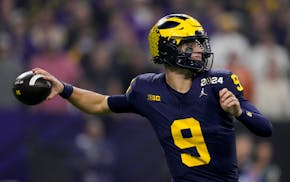To some degree, there is a comfort for Andre Hollins in the Gophers' slipups. He rationalizes that those mistakes mean the team has plenty of room to improve and avenues to climb.
"We're beating ourselves," he said. "It's not a panic situation where we're like, 'We're playing our best and we didn't win.' At the end of the day, it comes to us and we've got to correct ourselves."
That is certainly undeniable.
But as the Gophers head into Sunday's game against Illinois, the concern is not that Minnesota isn't playing its best but that the biggest problem with the squad has only gotten more problematic as the season has progressed.
While the turnover average for the Gophers -- who are ranked 225th in the nation with a 20.8 turnover-per-possession percentage -- is slowly but steadily declining (from 16.1 per game after the first seven to 13.2 now), there is more to the issue than seen at first glance. And combined with another growing concern -- poor shooting -- the miscues are only getting more exposed and becoming more costly.
Minnesota's turnover problem is nothing new -- the Gophers have struggled with it since the second game when they went from nine turnovers against American to 19 against Toledo. They were able to overcome them in nonconference play simply because they were more talented than their competition. And the Gophers were able to win their first three Big Ten games despite making 46 turnovers because they shot so well. Even in a loss at Indiana in which they commit 17 turnovers, the Gophers were able to nearly author a huge comeback by sinking 11 three-pointers.
Minnesota was sloppy at times then. But the Gophers have had a different concern lately. Instead of risking too much, they are playing timidly now. Because of the Gophers' overly cautious approach, they aren't creating the offense they need.
In their past three losses (at Northwestern, Wisconsin and Michigan State), the Gophers have shot less than 37 percent while still turning the ball over -- now due to a stagnant offense -- which creates an even larger problem.
"I think we're just attempting passes sometimes that there's just no reason for them," coach Tubby Smith said. "In these games ... you've got to be even more conscientious of taking care of the ball, and I'd rather err on the side of cautiousness than the other side."
But the argument that the Gophers have cut down on mishaps recently is deceptive.
At Michigan State on Wednesday, the Gophers had only 12 turnovers, which the Spartans cashed in for 19 points. But the Gophers had their second-fewest possessions of the year against the Spartans, so Minnesota still turned the ball over on 21.8 percent of its possessions, which is actually greater than its average.
"Every possession counts," Hollins said. "Michigan State didn't turn the ball over in the first half. Some people think that's impossible, but it's not. You just have to concentrate."
Similarly, at Wisconsin, the Gophers had only nine miscues, but they had a season-low 50 possessions (meaning that they turned over on 18 percent of their possessions). It's tough to take that as too great a victory. The Gophers made only six turnovers against Nebraska, but the Cornhuskers are just 2-8 and forced an average of only 9.9 turnovers in conference play.
"Sometimes [it's] just lazy passes, trying to do too much," forward Trevor Mbakwe said. "I think sometimes we rush things, and that's when we get out of character and make mistakes like that."
The problem is, at this point, those mistakes are part of the Gophers' character, a trait they hope to amend.

Live: Vikings draft QB J.J. McCarthy, edge Dallas Turner
NFL Draft Latest: Caleb Williams to Bears, record six QBs taken in first 12 picks
2024 NFL Draft: List of first round picks

